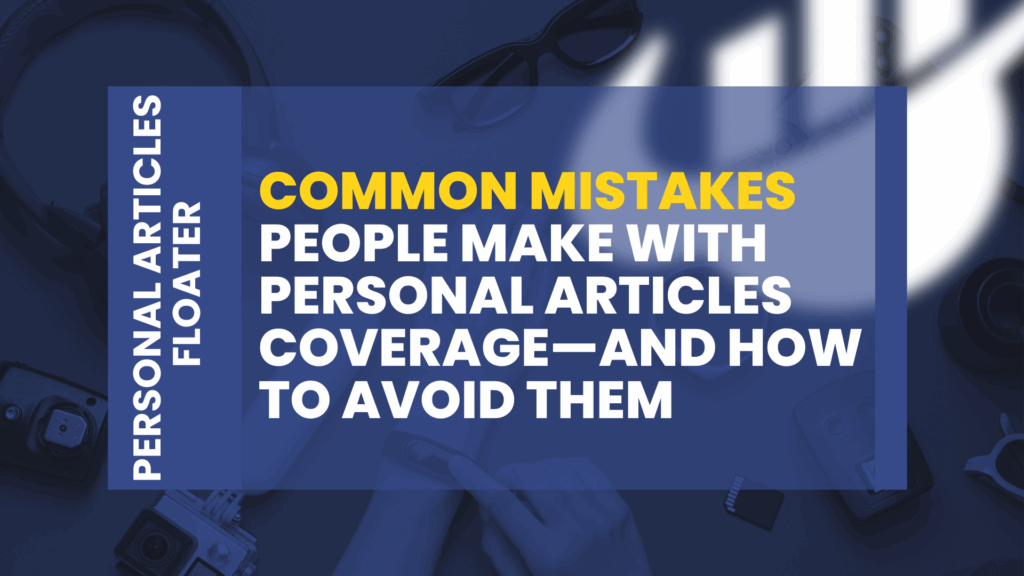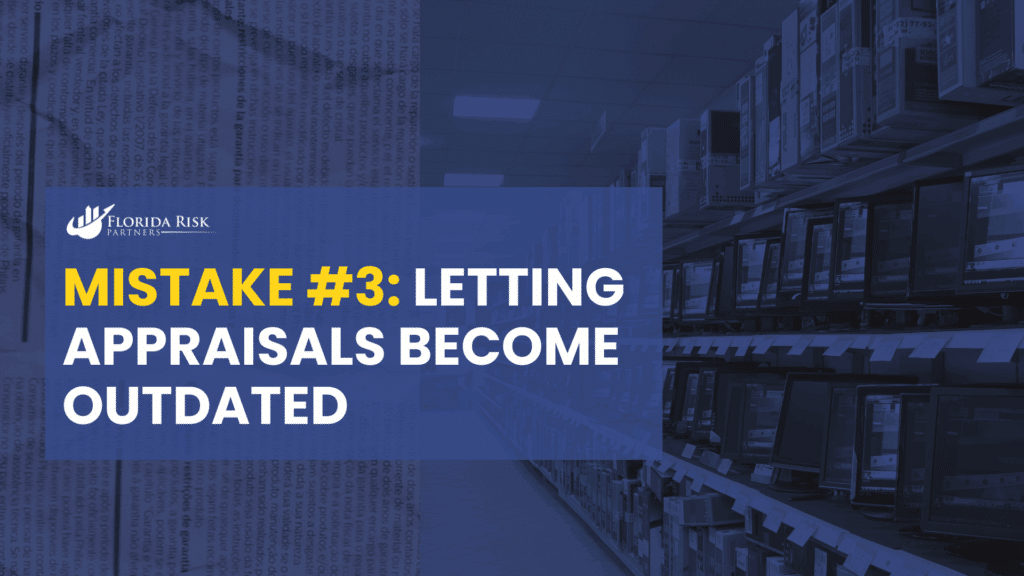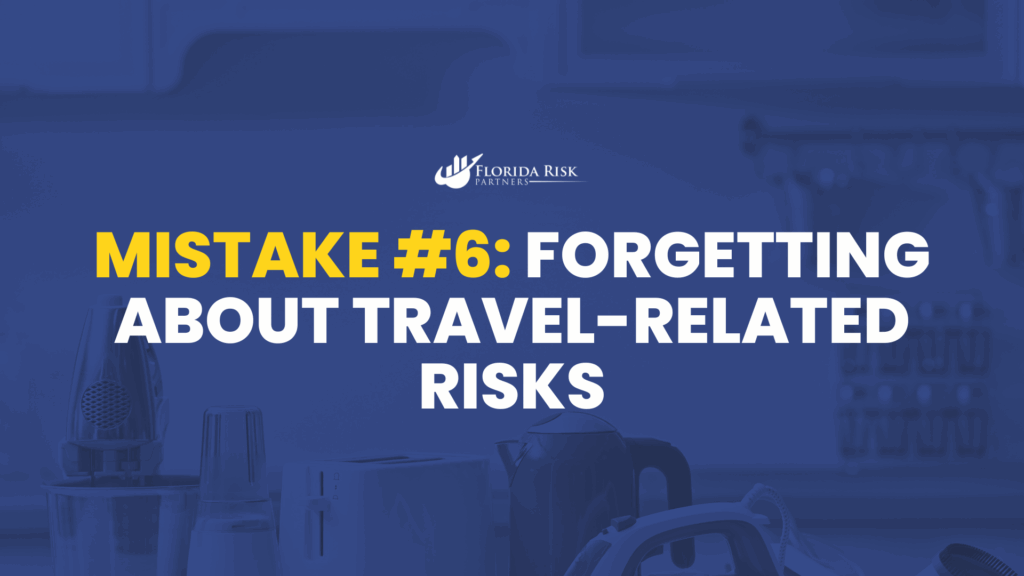-
Main Office: 1434 E. Bloomingdale Ave Valrico, FL 33596-6110
-
Phone: (888) 601-6660
-
Email: info@floridariskpartners.com

If you’ve been following this 12-week series on Personal Articles Floaters, you already understand that your homeowners insurance often fails to protect your most valuable possessions adequately. Whether you own jewelry, electronics, collectibles, or fine art, relying on standard coverage leaves many policyholders underinsured and exposes them to serious financial loss when something goes wrong.
So far, we have explained what personal articles floaters are, how they work, who needs them, and how to properly appraise and document your valuables. However, despite this knowledge, many policyholders still make critical mistakes—such as oversights, misconceptions, and assumptions—that can unravel the protection they have worked hard to establish.
Therefore, this week, we focus on the most common personal articles coverage mistakes—from failing to schedule new purchases to letting appraisals expire—and offer practical steps to help you avoid them. Use this as your personal audit guide to finalize or refine your coverage strategy effectively.
Mistake #1: Assuming Your Homeowners Policy Is Enough
The single most common mistake people make is assuming their homeowners or renters policy automatically provides full coverage for high-value items. Unfortunately, it doesn’t. These base policies often have strict sublimits for certain types of property, including:
- Jewelry: $1,500–$2,500 (usually for theft only)
- Firearms: $2,000–$2,500
- Silverware: $2,500
- Electronics: Capped at low limits, often depreciated
- Collectibles: Frequently excluded or subject to minimal coverage
Many standard policies exclude losses caused by mysterious disappearance, accidental damage, and incidents that occur away from home. As a result, they fail to adequately protect items you travel with or use frequently.
To avoid this problem, carefully review your policy limits and exclusions. If you own anything worth more than $1,000 to $2,000 that would be difficult to replace, you should strongly consider adding a floater.
Mistake #2: Not Scheduling High-Value Items
Even those who purchase a Personal Articles Floater can make the mistake of not scheduling individual items that exceed blanket coverage limits. Blanket coverage is convenient—it allows you to insure a group of items without itemizing each one—but it usually comes with per-item caps (e.g., $2,500 per item, even if the total blanket limit is $25,000).
This means if you have a $10,000 engagement ring or a $7,000 watch and you haven’t scheduled it separately, you could be on the hook for thousands in the event of a loss.
How to avoid it: Know the per-item limit of your blanket coverage and schedule any items that exceed it. It takes a little more time to document and appraise each piece, but it’s worth it for the full-value protection.
Mistake #3: Letting Appraisals Become Outdated

Many types of personal property—especially jewelry, fine art, antiques, and collectibles—appreciate over time. If your appraisal is five or ten years old, there’s a strong chance your item is now worth significantly more than what it’s insured for. If a loss occurs, your payout may be based on an outdated value.
This is especially problematic when using agreed value coverage, which locks in a payout amount based on your appraisal.
How to avoid it: Reappraise high-value items every 3–5 years, or any time the market experiences significant change. Be sure to provide your updated appraisals to your insurance agent so your policy can be adjusted accordingly.
Mistake #4: Not Updating Your Inventory After New Purchases
Another common oversight is failing to add new items to your floater policy after you acquire them. Whether it’s a new camera, a designer handbag, a rare collectible, or a luxury watch, items that are valuable enough to require specialized coverage need to be scheduled (or added to blanket coverage) as soon as possible.
Unfortunately, many people assume their existing policy will “just cover it”—until they file a claim and discover the item was never listed.
How to avoid it: Set a personal rule: any time you purchase an item over $1,000, notify your insurance advisor and add it to your floater. You can also schedule a semi-annual or annual review of your inventory to catch anything you’ve missed.
Mistake #5: Ignoring the Business Use Exclusion
Most homeowners and personal property policies exclude coverage for business use. Therefore, if you use your laptop, camera, musical instrument, or other equipment to earn money—even part-time or occasionally—your policy may not cover it at all.
In fact, many policyholders have filed claims after losing or damaging business-used items, only to have their claims denied entirely.
To avoid this, be honest with your agent about how you use your belongings. If you use any item to generate income, you may need a commercial floater, a business property endorsement, or an entirely different type of policy.
Mistake #6: Forgetting About Travel-Related Risks
Personal items are at higher risk when you’re on the move. Theft, loss, breakage, and mysterious disappearance are all common during travel. Unfortunately, most homeowners policies only provide limited off-premises coverage—typically 10% of your personal property limit—and often exclude mysterious disappearance or loss outside of the home.

Travelers who aren’t aware of these limitations may find themselves denied coverage for valuable items lost or damaged abroad.
How to avoid it: Ensure your floater includes worldwide protection and mysterious disappearance coverage, both of which are typically standard features. Double-check that your scheduled items are listed and fully covered even when they’re taken outside your home.
Mistake #7: Not Keeping Proof of Ownership
In the event of a claim, your insurer may require proof that you owned the item, what it was worth, and its condition before the loss. Without receipts, photos, or appraisals, you could face delays, disputes, or denials.
This is especially true for blanket policies, where individual items are not listed. Even with a scheduled item, updated photos and documentation can help smooth the claims process.
How to avoid it: Maintain a digital and/or physical folder containing:
- Receipts or invoices
- Appraisals or valuations
- High-quality photos
- Serial numbers or identifying marks
- Certificates of authenticity (if applicable)
We recommend using a home inventory app or spreadsheet to keep track of these details. If you haven’t already, download our free inventory tool:
Mistake #8: Underinsuring Items with Sentimental Value
Some people often underestimate the importance of insuring items that hold more emotional than financial value—such as an heirloom bracelet, a wedding ring, or a grandfather’s watch. Although these items may not be the most expensive in your home, they usually prove the hardest to replace or live without.
Furthermore, many assume these items are irreplaceable and therefore not “worth” insuring. However, insurance isn’t just about replacement; it focuses on restoring your financial position and providing peace of mind.
To avoid this mistake, consider whether losing an item would devastate you emotionally or financially. If so, that’s a strong signal to schedule it. Even if you cannot replace the exact item, having the funds to purchase something similar or commission a replacement can offer comfort and healing.
Mistake #9: Overlooking “Hidden” Valuables
You might be surprised how many valuable items are hiding in plain sight. People often overlook:
- Designer fashion (handbags, shoes, sunglasses)
- Vintage furniture or décor
- Musical instruments in storage
- Collectible toys or trading cards
- Expensive tools or specialty hobby equipment
These items may not be used daily, but they still carry significant value and could be lost in a fire, flood, theft, or accident.
How to avoid it: Go room-by-room with a fresh set of eyes. If the item would cost more than $1,000 to replace, consider documenting and insuring it. Include closets, garages, storage units, and attics in your review.
Mistake #10: Not Reviewing Coverage Regularly
Your life changes—so should your insurance. Too often, people purchase a floater once, schedule a few items, and never revisit their coverage again. Years go by, values change, new items are acquired, and your policy no longer reflects your current reality.
How to avoid it: Schedule a yearly coverage review with your insurance advisor. Walk through your inventory together and make updates. This is also a good time to check for:
- Expired appraisals
- Missing documentation
- Recently acquired or gifted items
- Items you no longer own
Final Thoughts: Good Intentions Aren’t Enough—Take Action
Most people who make these mistakes didn’t mean to leave their valuables underinsured. They assumed they were covered. They forgot to follow up. They didn’t realize the limitations of their homeowners policy. But when disaster strikes, good intentions don’t result in reimbursement—only proper planning does.
A Personal Articles Floater is one of the most effective tools you have to protect the things that matter most. Avoiding these common mistakes ensures your policy works when you need it most—no surprises, no disputes, just support.
Next week, in our final installment of this series, we’ll show you how to bring it all together: how to review, maintain, and future-proof your personal property protection plan for years to come.
Call Us Or
Schedule an Appointment
Select an agent below to view our online calendars and select a day and time that works best for you or call us directly at 888-601-6660. When you use our online calendars, you will receive an email with more information.



